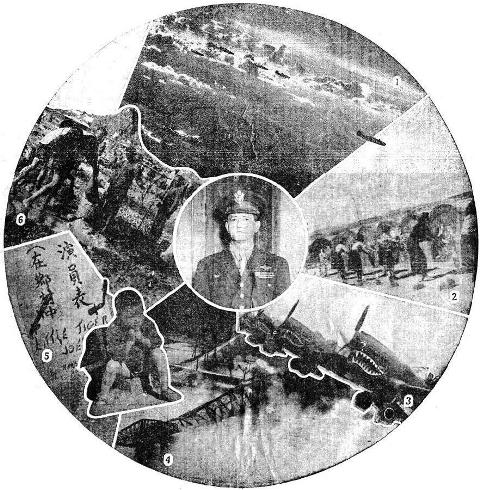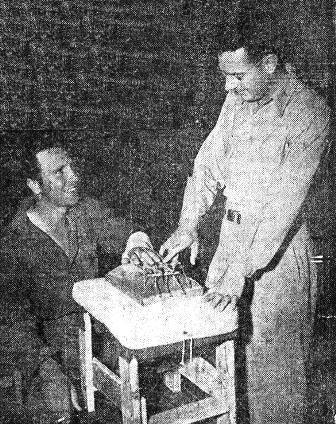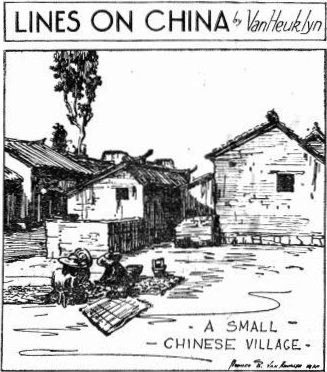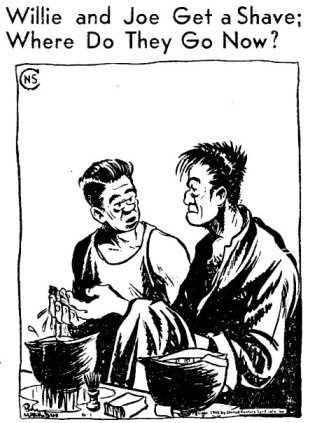
Chinese Patrols Cross Into
Indo-China; Kweipin Taken
HQ., U.S. CHINESE COMBAT COMMAND, Kunming, July 5 (Special to The China Lantern) - Liuchow was occupied this week by Chinese forces. Both the city itself and the former Fourteenth U.S. Army Air Force airfield south of the city are now in Chinese hands. All Japanese forces formerly in the area are moving northeastward toward Kweilin except for two small pockets which have been cut off and are in the process of being liquidated.
This means that the Chinese have now regained the second former Fourteenth Air Force base in a little more than a month and have widened the gap in the formerly Jap-held corridor between central China and French Indo-China. Since the fall of Nanning on May 27, the Japanese have now relinquished a distance of approximately 200 air-line miles of the corridor which they established last year with the capture of the Hengyang - Kweilin - Liuchow - Nanning route south from Changsha to Haiphone and the French Indo-China area.
REARGUARD FIGHTING
For several days before the Chinese occupation of Liuchow was officially confirmed, conflicting rumors and semi-official reports served only to obscure the true picture of what was actually going on. Although the Japanese evacuation of the city and airfield had all the appearance of being part of a major plan of withdrawal northeastward toward central China, stiff fighting was reported as the Chinese edged forward against Japanese rear guard elements left behind to deny the city and airfield to the Chinese as long as possible and protect the main Japanese body's withdrawal.
PATROLS CROSS INDO-CHINA BORDER
meanwhile, the Chinese are moving in other directions to regain more territory wrested from them last year. To the southwest of Nanning, the city of Pingsiang, only a few miles from the French Indo-China border, was under attack by Chinese forces. At some points, Chinese patrols actually crossed the border in reconnaissance probes but not in sufficient force to foreshadow any future major developments.
Eighty miles southeast of Liuchow, the Japanese also were withdrawing along the West River, toward the Canton-Hong Kong area, closely followed by Chinese troops. During the week, Kweipin, roughly 180 miles west of Canton, was occupied by the Chinese.
Renewed fighting flared up during the week in the Paoching-Hsinning sector in Hunan province. The Chinese, in small-scale offensive operations, captured two small villages within less than 10 miles of the Japanese Paoching base and one small settlement practically at the outskirts of Hsinning. Still another Chinese column was reported approximately 15 miles east of Hsinning, in what may be intended as a flanking operation.
Elsewhere in China there was little action.
|
THE JAPANESE, frankly scared of an Allied landing along the China coast, have pulled out of the southeastern ports of Foochow and Wenchow, thereby opening no particular doors to the Asiatic mainland.
Both ports are silted and undeveloped, and have only poor roads leading to the interior.
Meanwhile, the Japanese have abandoned their land corridor down through China. Maj. Gen. Chennault says this means they have revamped their defensive strategy. They have built extensive fortifications around Shanghai, the most desirable port in China, and apparently intend to hold Hong Kong for its nuisance value.
ONE POINT in considering a landing on the China coast is transportation inland - or lack of it. There are practically no highways to the interior except in the north. Railways reach the coast only at a few points, and nowhere between Hong Kong and Shanghai.
Sea approaches to ports along the entire coast from Indo-China to the Hangchow estuary, just south of Shanghai, are difficult. harbor entrances are often blocked by many islands, and waters are shoal. Rivers also are badly silted. However, a skilled pilot who knows the territory could maneuver a large vessel fairly close to shore at many spots.
The Yangtse River, north of Shanghai, is navigable clear up to Hankow. However, the mouth of the river is a wilderness of islands and sandbanks.
In 1937 the Japanese took Shanghai from the south, by landing on the northern shore of the Hankow estuary. Shanghai is one of the biggest ports in the world, and it lies on flat ground.
The Japanese have ordered all their civilians out of Shanghai and have announced plans to remove a million Chinese also. This is taken as an indication of their nervousness about a possible attack there.
Sand banks and salt flats extend along the coast for 300 miles above Shanghai. At Lienyun approaches
|
The water gets deeper and the coastline higher north of Lienyun, until Tsingtao is reached. Tsingtao is a deep water harbor, situated in a well-protected bay. The Germans held a lease on it until after the first World War. In that war the Japanese (on our side that time) tried to capture it from the sea but were badly mauled by German shore batteries. They finally landed on the north shore of the Shantung peninsula and took Tsingtao from the north.
Any resemblance on the map between Shantung peninsula and the Norman peninsula where the Allies landing in France is somewhat misleading. Shantung is mountainous and has only one railroad, which leads to Tsingtao. Its coast is generally forbidding.
LANDINGS NORTH of the Shantung peninsula don't seem to be in the cards at all, at least until an advanced stage of the campaign, if there is to be one.
The Japanese would dominate the region from Korea. However, if it's considered advisable to move on Manchuria from the sea, there are several ports that might possibly be used.
Shanhaikwan, Hulutao and Newchwang are on deep water and fairly approachable. These are all above the end of the Great Wall. Between the Shantung peninsula and the Great Wall is the old flood plain of the Yellow River - salt pools, tidal flats, sand bars and marshes.
Tientsin is the only port in this area. It must be approached on the Hai River, which must be dredged to accommodate ships of 4,000 tons. A Liberty ship is 10,000 tons.
Station Hospital Gets Merit Award
HQ., SOS, KUNMING - Award of the Meritorious Service Unit plaque for "superior performance of duty in the completion of exceptionally difficult tasks under adverse conditions" was made to a Station Hospital near here today in orders published by Maj. Gen. H. S. Aurand, commanding general of Services of Supply.
The plaque was presented to an assembly of nurses, medical officers, and medical corpsmen by Col. Douglas L. Crane, Tampa, Fla., deputy commander of SOS, at a ceremony in the Red Cross building at the hospital.
The award of the Meritorious Service Unit plaque entitles all hospital personnel to wear the laurel wreath on sleeve of uniforms.
The award citation stated it covered the period of October 15, 1944 to February 15, 1945 and all personnel assigned and attached to the unit. It stressed also the maintenance of high standard of military discipline and efficiency.
Col. Alexsei Leonidoff, commanding the hospital, received the plaque on behalf on the unit personnel. He said all of the nurses, medical officers, and enlisted personnel of the unit will be proud of the award distinction.
"This is the first medical unit in China to receive the Meritorious Service Plaque," declared Col. Crane, in his presentation.
 Bombers of the Fourteenth Air Force's hard-hitting Chinese-American Composite Wing daily are wrecking havoc on
Japanese operated railroads and communications lines in interior China. These remarkable photos were taken during
a recent strike against enemy railroad tracks and yards at Siaokichen. (1) Bombs from a B-25 Mitchell bomber of the
"Gambay" group leave the bomb-bay. (2) Initial hits on the target are clearly shown in this
photo. (3) Raging fires
and billowing smoke mark the destruction of the railroad yards at Siaokichen, China. (4) Huge clouds of
black smoke
obscure the target which was completely devastated.
Bombers of the Fourteenth Air Force's hard-hitting Chinese-American Composite Wing daily are wrecking havoc on
Japanese operated railroads and communications lines in interior China. These remarkable photos were taken during
a recent strike against enemy railroad tracks and yards at Siaokichen. (1) Bombs from a B-25 Mitchell bomber of the
"Gambay" group leave the bomb-bay. (2) Initial hits on the target are clearly shown in this
photo. (3) Raging fires
and billowing smoke mark the destruction of the railroad yards at Siaokichen, China. (4) Huge clouds of
black smoke
obscure the target which was completely devastated.
|
|
'Beautiful Goblins' Caused
Chungking Cholera Epidemic
CHUNGKING, July 5 (UP) - Facing an acute shortage of medicines and placing only a partial confidence in Western medical science, the majority of Chungking's 1,200,000 population believed the recent outbreak of cholera which killed hundreds of people in this war-time capital the mischief done by "two beautiful goblins."
Instead of using inoculations as a precautionary measure against cholera, thousands of Chungking's households used paper red crosses placed above the doors as protection. On the two pieces of red paper were written the characters which is equivalent to "Buddha will give protection against diseases." Meanwhile the Temples for the Goddess of Mercy, of which there are many in Chungking and its neighborhood, have seen huge crowds of worshippers since May, who are asking the Goddess for mercy and protection against the terrible disease.
'GOBLINS FROM HEAVEN'
According to a widespread popular belief among the common people here, the two beautiful goblins "arrived on Earth from Heaven" on June 18, to kill "bad people." In the middle of the night, the two goblins went to an inn near the South Gate of Chungking and were given a room next to the landlady. Later in the night the landlady overheard a whispered conversation between the goblins of their mission to the Earth and learned from the conversation that the only protection would be two pieces of red paper pasted above doors like a red cross. At dawn the two goblins disappeared, but the story spread from mouth to mouth and soon was known to every household in town.
"Prescription left by my ancestors" advertised by some local herbalists is reported to have killed many. In one case it killed the herbalist himself and his wife and a friend of his.
The City Health Bureau and medical officers from the U.S. Army and Navy stationed in Chungking helped to inoculate many people, but still only a small portion of the total population of Chungking. While the cholera wave is gradually dying down, the general belief among the ignorant however is that the "two beautiful goblins have completed their heavenly mission."
CHIANG FOURTH OF JULY MESSAGE
CHUNGKING, July (AP) - In a message sent yesterday to President Truman on the occasion of Independence Day, Generalissimo Chiang Kai-shek said that the Chinese people were united with the Americans "in honoring the memory of the founders of their great republic and in paying homage to those brave sons of America who have given their lives for the cause of justice and democracy."
EXCEPT FOR 'MRS. TANAKA'
Jap Withdrawal Ill Planned; Airstrips, Bridges Left Intact
By GEORGE K. T. WANG
CHUNGKING, July 5 (UP) - The planned Japanese withdrawal from the Kwangsai section of their formerly dreamed of trans-continental corridor was not carried out in a thoroughly planned fashion.
Evidence for this lack of planning in the withdrawal from this abandoned portion of the Tokyo-Singapore pipe-line is contained in the following facts I gathered on an inspection trip through the areas.
1) Only minor efforts were made by the withdrawing Japanese to destroy installations, large and small, scattered along this section of the corridor.
2) Apparently the Japanese did not destroy a single bridge on the corridor.
3) Thousands of tons of white salt taken from Indo-China and stored in cities along this section of the corridor were not taken away by the withdrawing Japanese.
4) All three generators and other heavy equipment in the Nanning power plant were not taken away.
5) The Japanese failed to keep their withdrawal a secret, enabling Chinese commandos to closely follow the retreat, waylaying the Japanese at several points and inflicting heavy casualties.
AIRSTRIPS INTACT
As apposed to the destruction of the airfields by the Fourteenth Air Force in their withdrawal last year, a total of 10 dud bombs were buried by the Japanese on one field, the only damage made to the air strips.
The Japanese built a considerable number of small and large bridges on the corridor which were not destroyed. Some of the bridges bear inscriptions such as "built by the Amaori unit in the 29th year of the reign of Emperor Showa."
However, there was one phase of their withdrawal that was completed almost perfectly - the removal of the camp followers for their comfort houses.
"MRS. TANAKA"
There was one exception, "Mrs. Tanaka," who was deserted by a Capt. Tanaka who hurriedly crossed the river to the north bank and disappeared. Chinese commandos later captured "Mrs. Tanaka."
There were a number of signs of Japanese occupation left in the cities and villages along the corridor. In one house, marked in Japanese "occupied by the Nakamura unit," there was a picture drawn showing a Japanese woman in a flowery kimono apparently done by the Nakamura rear guard.
Beneath it was the Japanese caption, "Nakamura's sweet little thing: how happy merry making Nakamura; starved all us buck privates."
The uselessness of the corridor as a supply line caused by the ever present Chinese commandos according to the natives, was partially responsible for the semi-starvation and halfhearted "planned withdrawal."

|

|
SOS Schools Men For Cooler Work
HQ., SOS, KUNMING - A one week course covering all phases of refrigeration maintenance has just been completed under the supervision of Capt. William C. Piatti, Jackson, Miss., and T/Sgt. Elmo H. Bevington, Council Bluff, Iowa, of the Special Installations branch of the Quartermaster office.
Twelve portable one-ton York ice plants and 50 Universal coolers were recently received in China by SOS. Before these units could be sent out to organizations in the field, intensive schooling was necessary in refrigeration
|
Ice plants and coolers, like ice cream machines, will be distributed to base section commands and Air Corps units.
Twelve enlisted men and two officers from base section and Air Corps units attended the school. Those from the Air Corps included Lt. J. R. Suit, Suit, N.C., T/Sgt. H. L. Clark, Albuquerque, N.M., Sgt. A. T. Lane, Texarkana, Tex., Sgt. J. R. Jones, Corp. W. J. Farrell, Woodside, L.I., Corp. W. E. Green, Lafayette, Ga., and Corp. J. P. Temple, Muskegon, Mich.
Those attending from SOS base sections included Lt. Norman Smoczynski, Chicago, Ill., Sgt. G. W. Howard, Los Angeles, Calif., Corp. A. E. Van De Venter, Eugene, Ore., Pvt. C. J. Beardsley, Harrisburg, Pa., Pvt. C. A. Mitchell, New York City, Pvt. C. M. Stark, Louisville, Ky., and Pvt. W. Fitzgerald, New Haven, Conn.
MPs Intensifying Campaign
On 'Black Market' Operators
An intensified campaign to prevent the leak of United States Army supplies to unauthorized persons, with vigorous action against U.S. soldiers caught selling or battering either equipment or supplies to possible "black market" operators, was announced this week by the office of the Theater Provost-Marshal.
Particular attention was called to the Theater ruling that no item purchased from the Post Exchange will be permitted to be resold or bartered for profit in the civil market. In order that this is clearly understood, a statement to this effect, which must be signed by all G.I.'s, is inclined on the new PX cards.
With regard to this situation, Col. H. A. Davenport, Theater Provost-Marshal, said this week, "The PX supplies are for the comfort and pleasure of the U.S. soldiers stationed in this theater. Valuable Hump tonnage is being replaced by PX supplies, because the War Department feels that such supplies are necessary to the morale of the U.S. personnel in the war effort."
If the new PX ration policy fails, Theater officials are considering cutting the quota on PX items that are being found in the civilian market, and allotting the tonnage to other vital and needed supplies.
Col. Davenport stated that the Military Police and the Chinese civil police are cooperating closely in combating the "black market." Raids by the combined police groups are a daily occurrence upon stores displaying and selling U.S. equipment and will continue until the condition is stamped out.
In addition, all Chinese merchants have been instructed by the police to obtain the names of anyone attempting to sell U.S. Army equipment or supplies, and these names will be turned over to the U.S. Military Police for prosecution.
One bright note in the "black market" condition is the fact that very little of the material arriving in the Theater by way of the Stilwell Road is being pilfered. An efficient road block and checking system recently put into effect has prevented the carrying of contraband into the area.
|
WITH THE 14th AAF
1) On missions over the Fourteenth's 2,300-mile front, a wide variety of weather is encountered.
2) China shrine of the AAF in Kunming. Losses have been light but officers of the AVG, CATF and the Fourteenth who have given their lives for China's freedom rest here.
3) Shark-mouthed P-40s lined-up before taking off against the enemy. The familiar design was adopted by the AVG.
4) Direct hit made on the end of the railroad bridge at Ninh Binh in French Indo-China by the Fourteenth. Loss of the bridge forced the Japs to ferry their supplies and raw materials from Malaya and the East Indies across the river.
5) "Little Tiger Joe," ardent Tiger enthusiast whose life with the Chennaultmen, as recorded by a combat camera unit, is well-known to U.S. movie-goers.
6) Chinese workers building an airstrip for use by U.S. military planes.
Circle: Maj. Gen. C. L. Chennault
CACW C-47 Sets Operational Mark
AN ADVANCED CHINA BASE - An operational record of 404 hours and 10 minutes for one transport plane during a 30-day period was chalked up recently by flying crews of the Chinese-American Composite Wing, commanded by Col. T. Alan Bennett, and line crews of the "Service Commandos," commanded by Col. R. H. Wise.
The combined crews made 170 trips and kept the plane in the air 13 hours and 28 minutes per day - more than one half the total hours of the 30-day period. The plane carried a total of 400,691 pounds of cargo, averaging 3,935 pounds per loaded trip. In addition to the crews, 294 passengers were hauled. The average time for each trip was 2 hours and 23 minutes.
A veteran at carrying supplies over the rugged mountain terrain and through some of the world's most hazardous flying weather to advanced bases of the Fourteenth Air Force, "Old 410," as the plane is affectionately called by its crews, is a 1941 C-47 transport.
Originally operated by the Fourteenth Air Force, the plane was turned over to the Chinese Air Force in August 1942. It was flown by the CAF for two years and then transferred to the Chinese-American Composite Wing in August 1944. Up to that time operational records are not available. Since being in CACW service, "Old 410" has logged a total of 1,345 hours.
AAF USING WOMEN PILOTS, SAY JAPS
SAN FRANCISCO July 5 (UP) - A Japanese Domei agency dispatch broadcast by radio Tokyo claimed that Japanese anti-aircraft gunners at Kweilin last Saturday shot down three Mustang fighter planes piloted by American women.
The broadcast added that they were "dressed in smart outfits possibly designed by Walt Disney" and said that their aerial technique was inferior.
Elusive Jap Force Puzzles U.S. Chiefs
WASHINGTON - (ANS) - The Japanese air force, or lack of one, has developed into the biggest question mark of the Pacific war with top United States air generals divided over the puzzling question of why B-29s can roam at will without encountering interceptions.
Some, including Gen. George C. Kenny, chief air officer to Gen. MacArthur, think the Japs simply have run out of planes. Other believe the enemy force has been whittled down, but that a good-sized number are being held back to resist actual invasion. Brig. Gen. William Flood, chief of staff of the Seventh Air Force, returned from Saipan with the declaration that he frankly is puzzled by the situation.
Flood says the question no longer is how good the Japanese plane and pilot may be, instead it is where is he. Military Intelligence has always believed, Flood said, that the Japanese could produce from 1,200 to 1,500 planes a month. Bomber strikes have cut that down considerably but "we are not destroying as many as that."
Planes on Japanese home fields seemed to have crawled into holes. B-29s on scouting missions no longer see them scattered around airdromes. Flood said, "maybe they're saving them for a last grand finale to try to fight off an invasion." He said the suicide plane attempts "seem to be letting up."
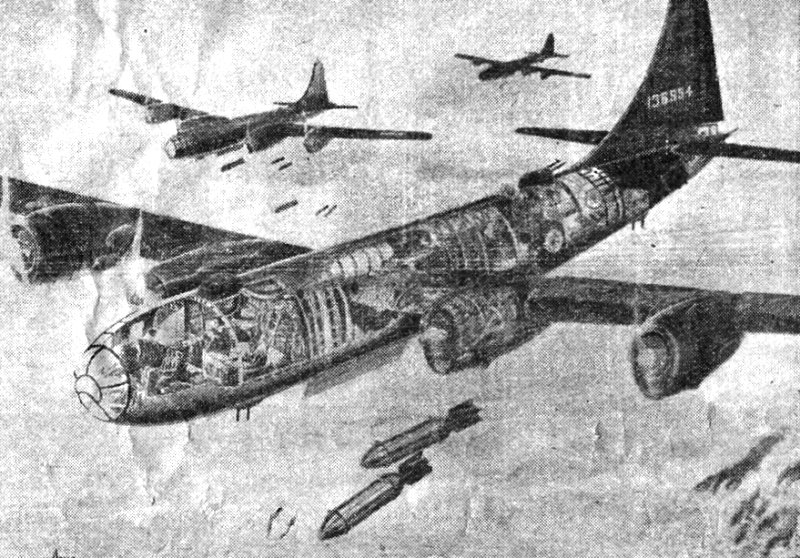 CUTAWAY DRAWING SHOWS B-29 INTERIOR - In the nose section sit the bombardier, pilot, co-pilot, flight engineer,
radio operator and navigator. A crew member is shown crawling through the long tube which spans the two bomb-bays of
the plane and connects the nose and the midsection. At the far end of this tube is the gunner's compartment and next
to that is the crew compartment, containing bunks. The tail gunner is stationed at the extreme end of the fuselage
with an unpressurized tail cone separating him from the midship section.
CUTAWAY DRAWING SHOWS B-29 INTERIOR - In the nose section sit the bombardier, pilot, co-pilot, flight engineer,
radio operator and navigator. A crew member is shown crawling through the long tube which spans the two bomb-bays of
the plane and connects the nose and the midsection. At the far end of this tube is the gunner's compartment and next
to that is the crew compartment, containing bunks. The tail gunner is stationed at the extreme end of the fuselage
with an unpressurized tail cone separating him from the midship section.
|
GI CHINA MYTHS
"Way I Heard It" or Tales That Spend The Lonely Hours
By Clyde A. Farnsworth
KUNMING, July 5 (AP) - "Now the way I heard it..." And your American soldier in China will cock his feet up and add another touch or chapter to the already vast but still growing collection of myths and legends related to the United States war effort in the Orient.
The most striking thing about these stories is that some of them might have a shred of truth but most of them defy any attempts at confirmation. But that doesn't put them from being good stories.
There's a recurrent myth propagated by crews of the plane that used to fly the Hump over the rugged north Burma route before the conquest of Burma permitted easier passages - the story of sighting a mountain a mile higher than Mt. Everest. So far as the writer knows the map coordinates of this peak have never been recorded.
BALL OF FIRE
Then there's the story of how the crew of a tanker bearing high octane gasoline was dismayed by a materialization of St. Elmo's fire that played eerily over the wings of the transport, threatening (the crewmen thought) to touch off their volatile cargo.
A ball of weird flame actually materialized inside the airplane, so the tale is told, and rolled back and forth and from side to side, with the pitching of the craft which was in a severe storm at the time.
More recent versions of this story have it that a thoughtful crewman took down the parachute exit panel and the ball of blue fire rolled out of its own accord.
There could be a whole dossier of stories related to smuggling and illicit disposal of government property which make the G.I. who sells his 60-cent carton of cigarettes for $20 or $30, American, look like a poor box thief. There's the tale of the fellow that sold a whole airplane on the black market, or engineered the disposal of an entire convoy. The raconteurs never stand short on anything but the names of people.
Stories bearing on easy contact between free and occupied China have been originated with rare imaginative skill. Without checking up, an American will tell you that it's possible to telephone long distance to Shanghai from certain parts of free China or that mail flows freely back and forth. But the rarest story of that sort (which at the outset should be labeled a complete fabrication) is of the G.I. who inadvertently visited Canton.
MYTHICAL STREAMLINERS
As this myth runs - and you hear it over and over - an American soldier in southeast China, riding the Hankow-Canton railway at the end of a long AWOL drunk slept through his appointed station and passed that mythical place where the free China train crew turned the train over on schedule to the trainmen for occupied China. He woke up with a headache in a large and strange railway station.
He wandered about, trying to find someone who spoke English and could direct him, and, failing, was about to approach one of the strangely uniformed soldiers he saw about the place. he thought they were Chinese. But before he reached them a Chinese touched him on the shoulder, told him "Boo-how," and led him away to safety.
The most glaring fault with this story is that when the Chinese controlled the inland section of the Canton-Hankow railway there were no rails linking occupied and unoccupied sections. The steel had been torn up for many miles through the border regions.
Then there's the legend of the bull session two or three American officers had with a Japanese officer at a China coastal port.
This tale seems to be a recent but research-proof origin when Chinese forces held the southeast China coast port and Japanese were still in occupation of nearby territory. The Americans had gone into town to see the sights, buy some of the famous lacquer souvenirs and have a good time in general. It makes the story better to think of it as a Saturday night.
At one place they were attracted by a sign in
 CAPTURED JAP TROPHIES, taken in an attack on a 42-truck Japanese motor convoy, displayed in a Chinese courtyard
in eastern China. Flags, arms, ammunition, gas masks and other equipment were among the captured prizes.
CAPTURED JAP TROPHIES, taken in an attack on a 42-truck Japanese motor convoy, displayed in a Chinese courtyard
in eastern China. Flags, arms, ammunition, gas masks and other equipment were among the captured prizes.
|
WAR-HATING JAP
They were about ready for second helpings when in walked a young Japanese officer. He spied them and walked up to their table, smiling, while their hands moved slowly toward their holstered pistols.
"You're American, aren't you," said the Japanese, shaking hands.
It developed that the officer had come to town on leave, that he had developed a taste for ice cream when he was going to school in America and that he like to talk with Americans.
"I wish to hell this war would get over with soon," he said. "I want to finish school."
They talked about this and that for a while, when the strain had eased, until the Japanese looked at his wrist watch and said he had to be getting back to camp.
"See you again sometime," he smiled. "Don't take any wooden nickels."
And the only trouble with this story is you'd have a hard time finding any of the American characters who are supposed to have been present.
|
Complete Recovery of Injured
KUNMING - At the U.S. Army Medical Corps convalescent camp, located on a lakeshore some miles from this city, skilled remedial therapeutic treatment and exercises are hastening the recovery of American troops in the China Theater following hospitalization for battle injuries, major operations, fractures and other casualties.
Under the direction of Maj. Clinton C. Millett, Omaha, Neb.; Capt. Julius R. Pearson, Miami Beach, Fla., medical officer, and Lt. Ben Rubin, Baltimore, Md., physical training director, the convalescent camp is an ideal vacation spot - just the sort of place to go to recuperate.
REMEDIAL THERAPY
With improvisation as the keynote, a complete remedial therapy gymnasium has been constructed to provide speedy rehabilitation for every conceivable type of injury and post-operative case.
S/Sgt. Edward I. Lantz, Philadelphia, Pa., is the instructor for remedial therapy. Under his guidance the camp staff, aided by the convalescents, have constructed such reconditioning machines as wall pulleys, stall bars, finger, wrist, shoulder and leg machines; weightlifting sets and many other devices to hasten recovery of injured muscles and limbs.
RECOVERY SPEEDED
In line with the most modern medical practice and theory, patients are being released from hospitals soon after they are well enough to get out of bed and are being sent to the convalescent campo for further treatment.
Patients operated on for hernia and appendectomy are sent to the camp within a week to ten days after the operation. Fracture cases go to the camp while still in the cast. Battle casualties and other wounds are also sent to the camp as soon as possible.
Remedial exercises aid in returning men with serious injuries and operations to duty weeks and even months sooner than was possible in the past.
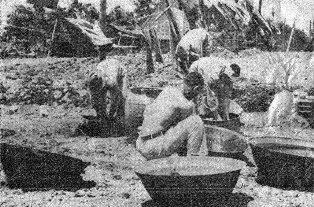 JAPANESE LAUNDRYMEN - Jap prisoners of war wash their clothes in tubs in prisoner enclosure on Okinawa.
Drying laundry hangs on barbed wires surrounding area. POWs are among 7,902 enemy troops captured
in bloody battle. Over 100,000 Japs were killed in campaign.
JAPANESE LAUNDRYMEN - Jap prisoners of war wash their clothes in tubs in prisoner enclosure on Okinawa.
Drying laundry hangs on barbed wires surrounding area. POWs are among 7,902 enemy troops captured
in bloody battle. Over 100,000 Japs were killed in campaign.
|
 AMBULANCES RECEIVING WOUNDED from U.S. Navy hospital ship Comfort which was attacked and heavily
damaged by a Japanese suicide plane that crashed on the mercy vessel last April 28. At the time of the attack
the Comfort was operating under full hospital procedure, was clearly marked with red crosses in large red
blocks against her white background and was fully lighted.
AMBULANCES RECEIVING WOUNDED from U.S. Navy hospital ship Comfort which was attacked and heavily
damaged by a Japanese suicide plane that crashed on the mercy vessel last April 28. At the time of the attack
the Comfort was operating under full hospital procedure, was clearly marked with red crosses in large red
blocks against her white background and was fully lighted.
|
 THE FACE OF THE ENEMY - These four types of Japs preferred surrender to hari-kari. Elderly Jap, upper
left, ponders wisdom of Emperor in attacking Pearl harbor. Treacherous Jap, upper right, appears humble but is
awaiting chance for trickery. Arrogant Jap, lower left, claims superiority to his captors. Grinning
buck-tooth Jap is favorite of Yank cartoonists.
THE FACE OF THE ENEMY - These four types of Japs preferred surrender to hari-kari. Elderly Jap, upper
left, ponders wisdom of Emperor in attacking Pearl harbor. Treacherous Jap, upper right, appears humble but is
awaiting chance for trickery. Arrogant Jap, lower left, claims superiority to his captors. Grinning
buck-tooth Jap is favorite of Yank cartoonists.
|
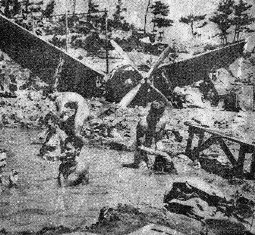 WARTIME SWIMMING' HOLE - Water-filled bomb crater provides refreshing pool for men of 6th Marine Division on
Okinawa. Grimy after furious fighting that placed island in Allied hands, boys bathe and wash clothing in
Naha airfield crater. Note wrecked Jap plane in background. Although mopping up and patrolling continue
on Okinawa, enemy planes appear no longer.
WARTIME SWIMMING' HOLE - Water-filled bomb crater provides refreshing pool for men of 6th Marine Division on
Okinawa. Grimy after furious fighting that placed island in Allied hands, boys bathe and wash clothing in
Naha airfield crater. Note wrecked Jap plane in background. Although mopping up and patrolling continue
on Okinawa, enemy planes appear no longer.
|
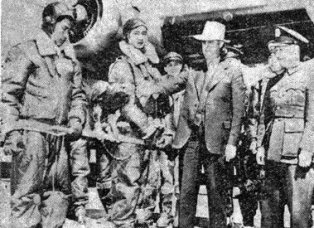 CHINESE AIR TRAINEES IN THE U.S. - members of an all-Chinese crew trained in the U.S. accept a pet eagle upon
their graduation from Pueblo Army Air Base, Colo. Not only is the eagle a symbol of the U.S., but it also
symbolizes the Chinese Air Force. Left to right, Sgt. Lei and Sgt. Wen, of the graduating group; Pueblo Park
Commissioner Ray H. Talbot, who presented the bird; and Col. Hsu Kang-liang,
commander of the group. The first
all-Chinese heavy bombardment teams graduated from Pueblo in Oct. 1944.
CHINESE AIR TRAINEES IN THE U.S. - members of an all-Chinese crew trained in the U.S. accept a pet eagle upon
their graduation from Pueblo Army Air Base, Colo. Not only is the eagle a symbol of the U.S., but it also
symbolizes the Chinese Air Force. Left to right, Sgt. Lei and Sgt. Wen, of the graduating group; Pueblo Park
Commissioner Ray H. Talbot, who presented the bird; and Col. Hsu Kang-liang,
commander of the group. The first
all-Chinese heavy bombardment teams graduated from Pueblo in Oct. 1944.
|
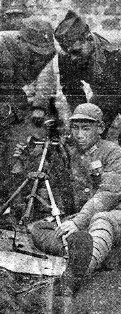 IMPLEMENTS OF MECHANIZED WARFARE are being supplied to Chinese armies. Here an American officer with the
Chinese Combat Command instructs Chinese officers in the use of an American 60mm mortar at a Chinese officers school
in Free China.
IMPLEMENTS OF MECHANIZED WARFARE are being supplied to Chinese armies. Here an American officer with the
Chinese Combat Command instructs Chinese officers in the use of an American 60mm mortar at a Chinese officers school
in Free China.
|
 HOT SHOT - S/Sgt. Walter J. Szulborski of Bethlehem, Pa., looks quite forlorn amid his ammunition at Langley
Field, Va. He made 50 missions over Europe without contacting a single enemy plane. Now he's waiting to
turn his sights on Tokyo.
HOT SHOT - S/Sgt. Walter J. Szulborski of Bethlehem, Pa., looks quite forlorn amid his ammunition at Langley
Field, Va. He made 50 missions over Europe without contacting a single enemy plane. Now he's waiting to
turn his sights on Tokyo.
|
|
|
USO 'Fun Time' Now Touring Forward Bases
AN SOS BASE, Southwest China - With a mountain serving as a balcony and the cement foundation of a new ward as the orchestra pit, USO Troop 497 recently staged a show at a hospital in this area.
Headed by Stan Kavanaugh, former Ziegfield comedy juggler, the entertainers set-up shop and went to work dispensing their unique brand of comedy amidst strange surroundings. The hospital was in the process of moving back into the hills, setting up new wards and new tents, but patients and medical personnel paused to enjoy USO's "Fun Time."
Included in the cast beside Kavanaugh are Eddie Mills, comedian, Don Palmer, accordionist and John Fogarty, former NBC singer.
USO Troop 497 is the only one which has toured the entire length of the Burma Road. It is now touring forward area bases.
Embryo Cowgirls Enter CTC's Rodeo
US CTC - Beauty will ride with the beasts at the Infantry Training Center's rodeo July 15th as a flutter of female applications came in with more than 150 others from all parts of Kunming.
The show - first of its kind ever to be held in China - was whipping into shape this week as stockades, chutes and pens rose in the fields beyond the city and stock and saddle contracts were closed.
A barbecue committee under Capt. Lowell Tash is planning 500 servings of Texas sweet-and-sour on show day, and Lt. Charles A. Lakin, former Arizona hand, has announced that entertainment, arena, procurement and prize committees are operating successfully under the experienced eye of Pfc. Loyce Morris, out of Texas by the Pacific to China.
Sgt. William Powell is completing construction of a rubber barrel which, as rodeo clown, he plans to baffle the bulls, and the Field Artillery Training Center's eight-piece string band is already tuning up.
Events are horse and mule bareback riding, steer riding, steer and calf roping, chariot race Roman tandem, and jeep roping. Applications may be obtained at the Red Cross Town Club or by writing the Special Service Officer, ITC, APO 627.
CHINESE SCIENTISTS AID WAR EFFORT
LONDON, July 8 (Globe) - Chinese scientists are carrying out intensive research which has already been of great value to their own and to their allies' war effort.
Among some important discoveries are an improved type of silk for parachutes, new types of radio apparatus, dependent on revolutionary methods worked out by the Chinese and special vaccines for medical purposes.
China has gone far beyond any other nation in the investigation of bamboo in aircraft construction. Bamboo, it is claimed, has many advantages over even the lightest wood.
Other developments which will help China in post-reconstruction include important surveys of plants which contain rubber sap, measure to prevent soil erosion and new scientific measures of manuring food crops.
Flying Tigers Bag 206 Water Craft In Day's Strike
HQ., 14TH AIR FORCE - July 5 (Special to the China Lantern) - During the week of June 27 to July 3 inclusive, fliers of the Fourteenth Air Force for the first time in 33 days encountered an enemy aircraft in the air. On June 29 over the southeast airdrome at Peiping, one Tojo was found airborne by Mustangs and destroyed. Two other enemy aircraft were caught on the ground during the week; one was destroyed at Peiping on June 27 and one Sally was damaged at Kaifeng airdrome on July 1.
Supporting Chinese ground forces, Fourteenth Air Force fighters and bombers hammered at enemy transportation, communications and supply lines, and troop concentrations. Damage to river shipping including steamers, junks, barges and power boats, accounted for more than 250 craft destroyed or damaged in the period covered. On June 28 alone, 206 small craft and 14 river boats of more than 100 feet were attacked.
|
One hundred and twenty-six locomotives in service of the Japanese, mostly north of the Yellow River were damaged or destroyed between June 27 and July 3. On July 1, in an area bounded by Kaifeng, Suchow, Tehsien, Taiyuan and Linfen, 30 locomotives were destroyed or damaged.
Operations of the Fourteenth Air Force extended southward to Fort Bayard on Liuchow Peninsula, where damage was inflicted on storage areas, and to Hoisow, principal port of northern Hainan island. At Hoisow, barracks areas and wharves were hit. On July 3, Mustangs ranged as far south as Haiphong in French Indo-China where barracks areas and river shipping was hit.

|
HQ., 14TH AIR FORCE - The "Flying Hatchet" fighter group and the "Lucky Lady" medium bombardment squadron have awarded Unit Citations for "outstanding performance of duty in action during the period of April 10 to May 15, 1945 when the Japanese attempted capture the airfield at Chinkiang but were defeated."
The Flying Hatchets fighter group is under the command of Col. John A. Dunning, San Antonio, Tex., and the "Lucky Lady" medium bombers are commanded by Col. T. Alan Bennett, Winter Park, Fla.
WEDEMEYER IN TRIBUTE TO CHIANG KAI-SHEK
NEW YORK - (ANS) - Lt. Gen. A. C. Wedemeyer, Commanding General, USF, CT, said in a Colliers magazine article last week that China's war effort, the target of recent criticism, could be "counted on for valuable contributions to the common effort" against Japan.
Gen. Wedemeyer said in the article he had come to regard Chiang Kai-shek "as a great leader and an inspiring unifying force."
|
|
|
The CHINA LANTERN is the weekly newspaper of the United States Forces in the China Theatre and is published by Lt. Lester H. Geiss, Editor-in-Chief, for military personnel only. Lt. Harry D. Purcell, Managing Editor; Sgt. Maurice Pernod, Production Chief. Editorial offices: Hqrs., SOS China Theater, Kunming, China, and Hqrs., SOS, Calcutta, India. Printed by Ajit Kumar Sinha at the "Amrita Bazar Patrika" Press. Unless specifically stated, news and features appearing in the China Lantern do not necessarily represent the views of the War Department; the Commanding General, USF, CT, or any other official source.

JULY 6, 1945
Original issue of The China Lantern shared by CBI Veteran DAVE DALE
Copyright © 2007 Carl Warren Weidenburner
TOP OF PAGE PRINT THIS PAGE ABOUT THIS PAGE SEND COMMENTS
AAF BIRTHDAY CLOSE THIS WINDOW


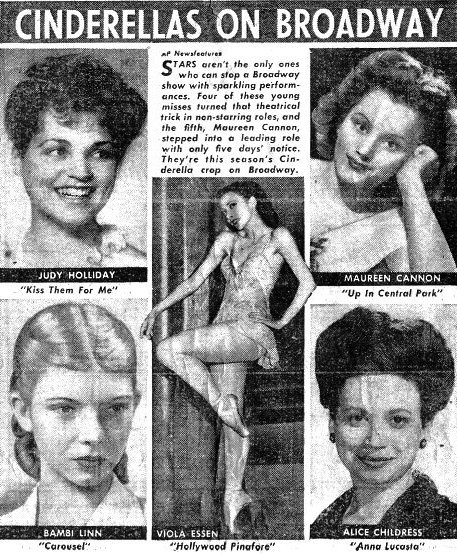
 HIGH WATER MARK may be seen from these buildings near the athletic field of the Station Hospital after flood
waters swept over the hospital site.
HIGH WATER MARK may be seen from these buildings near the athletic field of the Station Hospital after flood
waters swept over the hospital site.
 MUD-BRICK WALLS of small buildings at the station hospital were melted away in the path of the flood. Ambulatory
patients were guided out of the wards by rope made of sheets tied together by wardmen.
MUD-BRICK WALLS of small buildings at the station hospital were melted away in the path of the flood. Ambulatory
patients were guided out of the wards by rope made of sheets tied together by wardmen.
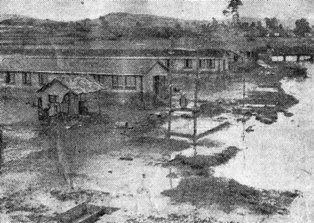 THE FULL FURY of the flood was caught by the new building at the hospital. The monsoon torrents swept small
service buildings completely away.
THE FULL FURY of the flood was caught by the new building at the hospital. The monsoon torrents swept small
service buildings completely away.
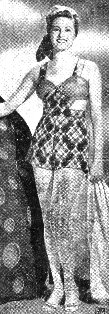 "JANE HARKER," quoth the press agent, "was a secretary typing the movie contracts of others, until a talent
scout spotted her. Now," he said, "she has a contract of her own, typed not by her, and a part in an Errol Flynn
picture. It just goes to show you."
"JANE HARKER," quoth the press agent, "was a secretary typing the movie contracts of others, until a talent
scout spotted her. Now," he said, "she has a contract of her own, typed not by her, and a part in an Errol Flynn
picture. It just goes to show you."
